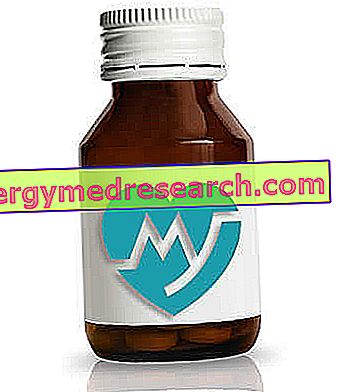MOBIC ® is a Meloxicam based drug
THERAPEUTIC GROUP: Non-steroidal anti-inflammatory and antirheumatic drugs
IndicationsAction mechanismStudies and clinical effectiveness Usage and dosage instructionsWarnings Pregnancy and lactationInteractionsContraindicationsUndesirable effects
Indications MOBIC ® Meloxicam
MOBIC ® is used in the long-term treatment of inflammatory joint pain during rheumatic diseases such as rheumatoid arthritis, osteoarthritis and ankylosing spondylitis.
MOBIC ® Meloxicam action mechanism
Meloxicam, the active ingredient of MOBIC ®, is a non-coxib non-steroidal anti-inflammatory drug, but with direct selective action against COX2.
These enzymes, important in the genesis of the inflammatory process, are expressed by the tissues subjected to various kinds of damaging stimuli, catalyzing the reaction that guarantees the conversion of arachidonic acid into prostaglandins.
These last molecules, by exerting a chemotactic, edemigenic and algogenic action support the inflammatory process and its consequences, contributing to the onset of histological damage in the long term.
Meloxicam therefore, in addition to blocking the aforementioned events, through a modest antioxidant and histoprotective action, protects the tissues from oxidative damage induced by reactive oxygen species while contributing to the reduction of pain.
The therapeutic efficacy of Meloxicam is also supported by the good pharmacokinetic properties that allow the aforementioned active ingredient taken orally to be absorbed in the intestine reaching in about 4-6 hours the maximum plasma concentration with a very high bioavailability, equal to 89% of the total dose taken.
After a half-life of about 15-20 hours and a hepatic metabolism supported by cytochromial enzymes, in particular CYP3A4, Meloxicam in the form of inactive metabolites is eliminated by urine and faeces.
Studies carried out and clinical efficacy
1. THE MELOXICAM IN THE PREVECTION OF DOPAMINERGIC DAMAGE
Neurosci Lett. 2012 May 19. [Epub ahead of print]
Experimental study that demonstrates how Meloxicam can inhibit the death of dopaminergic neurons in rats affected by Parkinson's, thus reducing the typical motor dysfunction characteristic of this pathology.
This activity would be linked to the neuroprotective role of cyclooxygenase inhibitors.
2 . MELOXICAM AND CHEMOTHERAPY FOR BREAST CANCER
Anticancer Res. 2011 Oct; 31 (10): 3567-71.
Work carried out on about 20 patients suffering from breast cancer who demonstrated that Meloxicam combined with chemotherapy, while not guaranteeing important therapeutic successes, could determine a better control of neuropathy.
3. THE MELOXICAM AS AN ANTICANCER
Int J Pharm. 2010 Mar 15; 387 (1-2): 223-9. Epub 2009 Dec 4.
Study demonstrating the time and dose dependent effectiveness of Meloxicam in controlling and inhibiting the proliferation of prostate cancer cells. These works could introduce Meloxicam as a possible adjuvant in the treatment of prostate cancer.
Method of use and dosage
MOBIC ®
7.5 mg coated tablets - 15 mg of Meloxicam;
Meloxicam 15 mg solution for injection per 1.5 ml of solution;
The dosing schedule useful for the symptomatological treatment during rheumatic diseases involves taking one tablet a day.
The choice of the dosage, 7.5 mg or 15 mg, should be made by the physician after having evaluated the physio-pathological characteristics of the patient, the severity of his clinical picture and the tolerability to the therapy.
The dosage adjustment becomes necessary in elderly patients or those suffering from liver and kidney diseases.
Warnings MOBIC ® Meloxicam
The use of MOBIC ® should be under strict medical supervision given the numerous side effects associated with Meloxicam-based therapy.
In order to reduce the incidence and severity of the side effects associated with the therapy it would be advisable to use the lowest possible dosage for the time strictly necessary to guarantee a remission or an improvement in symptoms.
The doctor should also carefully monitor, through periodic checks, the health status of patients suffering from cardiovascular, coagulative, renal, hepatic, allergic and gastrointestinal diseases, and at the same time undergoing therapy with MOBIC ®, given the greater susceptibility of these to the side effects of NSAID therapy.
If undesired effects appear, the patient, after contacting his doctor, should seriously consider suspending therapy.
It is useful to remember that Meloxicam therapy may interfere with some blood chemistry tests mainly related to liver and kidney function.
PREGNANCY AND BREASTFEEDING
The intake of MOBIC ® is contraindicated during pregnancy and in the subsequent period of breastfeeding, given the importance of prostaglandins in controlling the correct processes of cell proliferation and differentiation fundamental for the growth of the fetus.
Indeed, experimental studies show that the use of non-steroidal anti-inflammatory drugs during this period can significantly increase the risk of fetal malformations of the cardiovascular and urinary tract, as well as of spontaneous abortions.
The fetal side effects are added to those of the pregnant woman, subjected to an increased risk of bleeding and complications during childbirth.
Interactions
Different pharmacokinetic studies have shown the presence of numerous active ingredients, whose simultaneous intake could alter the therapeutic properties and safety profile of Meloxicam.
For this reason it would be appropriate to pay particular attention to the concomitant administration of:
- Oral anticoagulants and inhibitors of serotonin reuptake, due to the increased risk of bleeding;
- Diuretics, ACE inhibitors, angiotensin II antagonists, methotrexate and cyclosporin, due to their ability to enhance the hepatotoxic and nephrotoxic effects of Meloxicam;
- Non-steroidal anti-inflammatory drugs and corticosteroids due to damage to the gastro-intesintale mucosa;
- Lithium, given the increased toxic effects of the same;
Cholestyramine, given the ability to alter the half-life and clearance of Meloxicam.
Contraindications MOBIC ® Meloxicam
The use of MOBIC ® is contraindicated in case of hypersensitivity to the active ingredient or to one of its excipients or to chemically and functionally related active ingredients, angioedema, peptic ulcer, history of intestinal bleeding, ulcerative colitis, Crohn's disease or previous history for the same pathologies, cerebrovascular bleeding, hemorrhagic diathesis or concomitant anticoagulant therapy, renal and hepatic failure.
Undesirable effects - Side effects
Although Meloxicam has a selective therapeutic activity, taking MOBIC ® has often been associated with the appearance of sometimes clinically relevant side effects.
Different clinical trials and careful post-marketing monitoring show that adverse reactions are mainly concentrated in the gastro-enteric and dermatological systems.
More precisely, the use of Meloxicam, especially when continued over time or carried out at particularly high dosages, could determine the appearance of:
- gastric pyrosis, gastralgia, nausea and vomiting, constipation and in severe cases ulcers and hemorrhages;
- increased bleeding time, anemia, thrombocytopenia and leukopenia;
- hearing and sight disorders, headache, insomnia, drowsiness, confusion and tremors;
- erythema, rash, urticaria and in severe cases bullous reactions;
- edema, anaphylactic and anaphylactoid reactions;
- increase of transaminases, hyperbilirubinemia and hepatitis;
- palpitations, sloping edema and myocardial infarction.
Note
MOBIC ® is a prescription-only drug.



